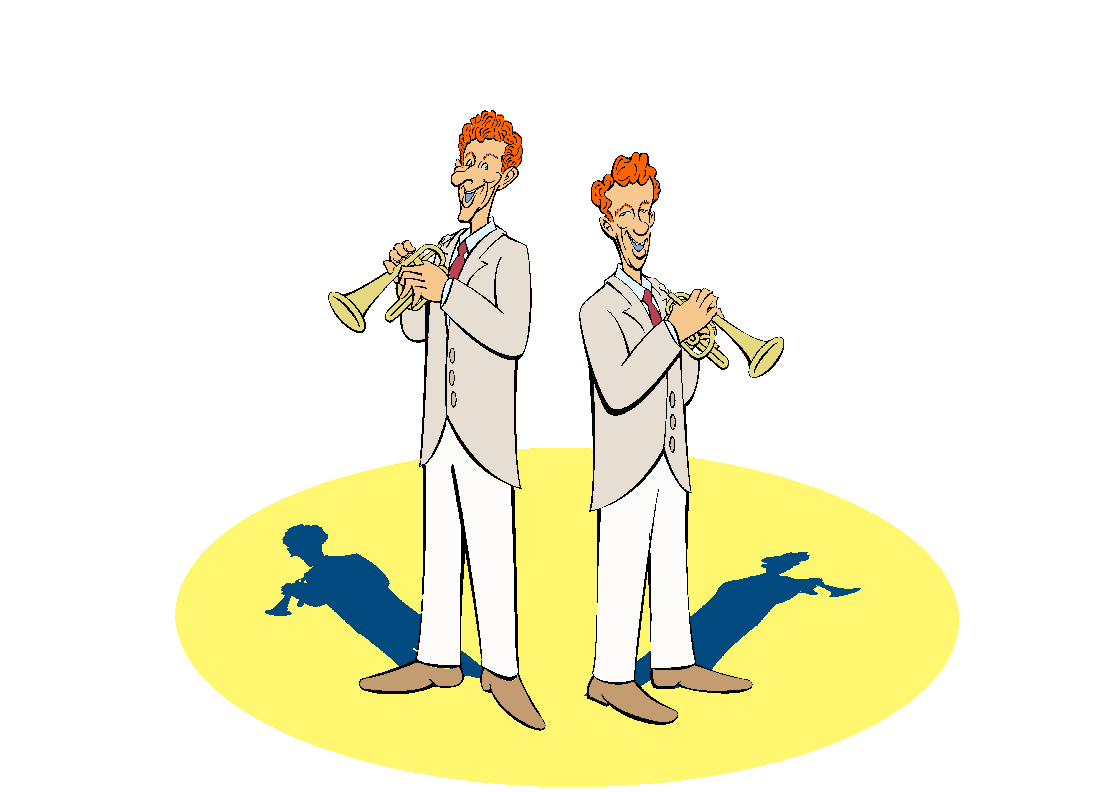
(Click to zoom in and out.)
| When Red wanted, he could outblow them all. | |
| - | Louis Armstrong |
It may have been due to the success of Universal's film The Benny Goodman Story in 1956 that three years later Paramount decided to come out with The Five Pennies. That was the story of Red Nichols, a trumpet player who in the 1920's and 30's was one of the most recorded jazz musicians in the world. Danny Kaye played Red.
Or the movie sort of tells the story of Red who strictly speaking was a cornet player. As reviewers have pointed out, the movie is a "fictionalized" version of Red's life.
For one thing the real Red didn't drink too much in a speakeasy1 while on a blind date with his soon-to-be wife, Willa Stutesman (called Bobbie 2 by her friends and played by Barbara Bel Geddes). Nor did he try to drunkenly horn in - no pun intended - on the stage act starring Louis Armstrong or after heaving out the liquor did he play a jazzed up version of "The Battle Hymn of the Republic" to prove to Louie (and Bobbie, of course) that he really was a jazz player.
Footnote
This scene is supposed to take place in the 1920's - the height of the Prohibition Era - with everyone drinking their booze out of tea cups.
Now although Red and Louie knew each other as young men, they didn't meet in a speakeasy. Instead it was in 1925 when Red had been in New York for almost two years and both were playing at the Roseland Ballroom. At the time Louie was not leading his own band, but instead was appearing with Fletcher Henderson.
But that Red had actually written his music down as we see in the movie is keeping with the real Red's modus playerandi. Throughout his life Red, who had a good and traditional music education, did routinely commit his songs to paper and he was a good arranger.
In the movie Red and Bobbie get married - which they did in real life - and she makes him sleep on the couch so they can get a good night's rest - which she didn't (the movie was from the puritanical 50's, after all). But later Bobbie begins to get weary of long road trips - scarcely a domestic model for raising their daughter, Dorothy. But Red doesn't see a problem and even takes Dorothy to the jazz clubs where she stays up to the wee hours of the morning. Talk about a "bring-your-daughter-to-work" day!
But Bobbie doesn't think it's a good idea for a preschooler to be out so late even if she loves the music, makes friends with the musicians, rehearses numbers with them, and even joins them in poker games. Besides, Dorothy should be starting school soon. Although at first Red didn't see any problem with such unique pre-school activities, after some thought he says the best thing is to put Dorothy in a boarding school. That way Bobbie can now travel with him and sing with the band. So we see Dorothy grows up with absentee parents who can't make her birthday parties and visit during the holidays.
Then when Red and Bobbie are on the road they get a call that Dorothy's in the hospital. She had contracted polio which in mid-20th century was one of the most feared afflictions of children. Red blames himself for his neglect and realizes that he and Bobbie can't care for their daughter if they're in a business that takes them on the road.
So Red decides to give up music. He takes his cornet to the Golden Gate Bridge and throws it into the water. The instrument seems to fall forever until it hits the water with a huge splash.3 Then Red goes to work in a local shipyard.
Footnote
Actually it takes about four seconds for an object dropped from the bridge to hit the water.
Move ahead nigh on a decade. At home the now 16-year old Dorothy (played by Tuesday Weld in an early film role) is having a birthday party. The kids had come across a stash of Red's old 78's and were playing them ("Some of them are pretty funny," says one. "Yeah, hilarious," says another4).
Footnote
Such comments are actually somewhat anachronistic. Although teenagers from 1959 (when the movie was released) might think of Red's music as "funny", if Dorothy was 16, the year would have been 1944. Teenagers - not a recognized concept until the 50's - were then still listening to Benny Goodman, Glenn Miller, and Tommy Dorsey. They might have thought of Red's music a bit old fashioned - much as Elvis was old hat to kids who favored the Beatles - but they likely would not have thought of it as humorous or hilarious.
Arguably the Swing Era was the last time the same popular music was enjoyed both by parents and their kids. Such a situation continued into the early 1950's and only came to an end with the rise of Rock and Roll.
Before Red gets home from work, Bobbie had been telling the kids and Dorothy, who seems to have forgotten her mom and Dad's early profession, about all the big names who once worked for her dad. After he arrives Red acts grumpy and ends up breaking up the party when he tries to play a cornet to prove to the kids he can still do it, only he can't ("Is he always like this?" one of the kids asks.)
Later Dorothy tells her dad that there's now no reason he can't go back into the business. But Red says he can't because it's clear he's "lost his lip" and it's something musicians can't get back. But after Dorothy speaks rather firmly to her dad for his defeatist attitude - likening him to a character Red had once made up for her, "Meyer the Crier" - she leaves the room. Then she hears her dad playing a scale. After a few flubs he ends up hitting a high C.5
Then the next scene cuts to a nightclub where Red's attempting his comeback. Although he had been practicing a whole month, the audience is sparse and it seems like everything's going to flop. But then as a surprise for Red, Louie Armstrong and the other famous players come out and join him on stage. So all ends happily ever after and Red Nichols returns to music.
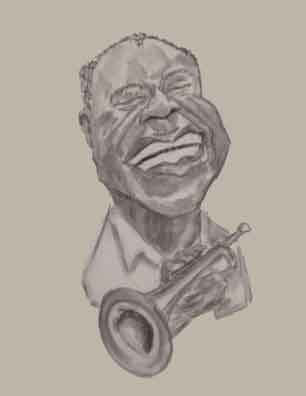
Louie
He didn't sing with Red.
That's the REEL Red.
And the REAL Red?
Ernest Loring Nichols was born in Ogden, Utah, in 1905, where his dad was a professor of music at Weber College (now Weber State University). Red began playing trumpet (or cornet) at age 4 and was good enough to be in a real band at age 12. He began playing professionally at age 17 and moved to New York in September 1923.
Red quickly established a reputation as a skilled player and an excellent sight reader. From 1924 Red played on over 200 recordings. The earliest platters which featured him as a band leader were made in 1927 when he and trombonist Miff Mole cut four sides. He also played in a number of bands led by others. One of these orchestras (as they were often called) was led by Blanche Calloway. Yep, Blanche was the sister of Cab.
What type of jazz did Red play? Well, the manner of how jazz developed is a complex topic and it's not easy to pinpoint any one style with any one group since there was as much individuality between musicians as there was between the genres.
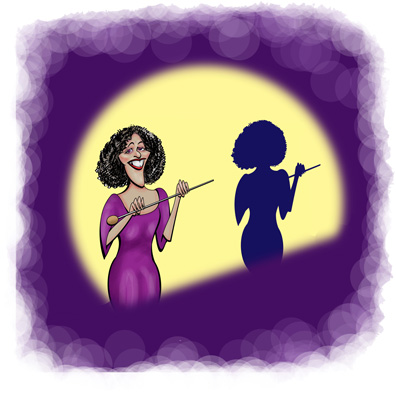
Blanche Calloway
Red played for her.
Few dispute that jazz originated from the black American blues and ragtime. But these styles were mostly music for voice and guitar (blues) and piano (ragtime). But in New Orleans these styles were adapted by brass bands left over from the Civil War. After some supplementation with clarinet, piano, and drums, jazz emerged from the clubs, dance halls, and in Storyville the ....
Well, let's just say that in the first years of the 20th century it was in New Orleans we had first true jazz.
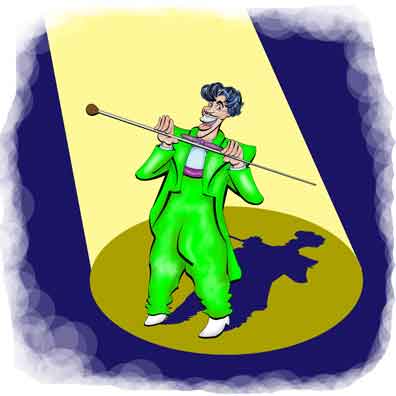
The Brother of Blanche
Nor do many dispute that the first commercially successful jazz band was The Original Dixieland Jass Band with their release of "Livery Stable Blues" in 1917. These were all white guys, and of course they were not the original Dixieland band even though they later changed their name to the Original Dixieland Ja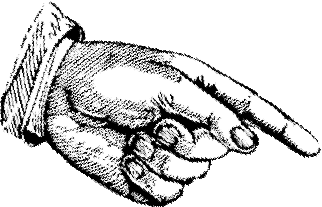 ZZ Band.6
ZZ Band.6
Footnote
Why the change in names is a big question. But some speculate that the original spelling made it too easy to make discourteous punning jokes.
Despite the name, the Original Dixieland Jazz Band was based in Chicago. The leader Nick LaRocca later became famous - some say infamous - for his insistence that the music was largely created by white musicians. But it can't be denied that the band was crucial to the rapid popularization of the music as a lucrative commercial product.
But why Chicago - "hog butcher of the world, city of the big shoulders" - of all places?
Chicago had become one of the major centers of the American Africa diaspora from the South and many black musicians settled there. These included none other than Joe "King" Oliver and his student, Louis Armstrong. There the New Orleans sound was modified to what became called (what else?) the Chicago style and moved east to New York which had become the entertainment capital of the nation.
You don't hear much about a genre called New York jazz probably because in New York you can hear pretty much anything. Even King Oliver and Louie made it east and played in the hot spots in Harlem. However, there were bands that began making a more conventional sound that was acceptable to older citizens who grew up in what were called the Gay 90's and who preferred music hall tunes like "Bicycle Built for Two", "The Man on the Flying Trapeze", "The Sidewalks of New York", and "(Casey Would Waltz With) The Strawberry Blonde [and the Band Played On]".
By the 1920's an offshoot of the various styles had produced tunes of fairly simple melodies and harmonies, and we must admit it, greater commercial success that ultimately led to the "symphonic" jazz of Paul Whiteman. It was Paul who was later to commission (and his arranger Ferde Grofé would orchestrate) the quintessential symphonic jazz composition, George Gershwin's Rhapsody in Blue. The music was strictly choreographed with danceable tempos which ultiamtely led to the not-yet born Swing Era. It may have been Paul's music which confused Russian composer Dmitri Shostakovich since his famous Jazz Suites isn't remotely jazz.
Although at times dismissed for excess schmaltz, Paul nevertheless employed many of the soon-to-be legends of jazz. We're talking Tommy and Jimmy Dorsey, Bix Beiderbecke, and (yes) Red Nichols. And it was Paul who was the best man at Red and Bobbie's wedding.
It seems rather confusing seeing so many names in the same bands and at the same time. While we see Paul having all the big names in his band, we also have Red organizing bands whose members also read like a Who's Who of jazz instrumentalists. Red's groups not only played under the famous "Five Pennies" moniker but were sometimes the Charleston Chasers, the Arkansas Travelers, the Red Heads, the Louisiana Rhythm Kings, the Wabash Dance Orchestra, the Alabama Red Peppers, Red and Miff’s Stompers, and Red Nichols' Stompers.
And yes, Red and his bands did utilize the talents of Glenn Miller, Jack Teagarden, Charlie Teagarden (Jack's trumpet playing brother), Tommy Dorsey, Jimmy Dorsey, Pee Wee Russell, Benny Goodman, Gene Krupa, and even the titanic Joe Venuti. One particularly unusual choice - at least to modern jazz ears - was Andrian Rollini, normally a skilled vibraphonist, who Red asked to take on the bass saxophone.
But after looking at the old recordings and the personnel emerges a natural question.
Exactly who was leading who?
The confusion is somewhat ameliorated if we realize that many musicians at this time (and today) performed as what we call session musicians. They were in essence independent businessmen who would work as contract workers for the various bands. Band personnel changed frequently - sometimes night to night - and many of the performers in a band would also have their own combos and orchestras.
So today you'll find records where Red leads a band with other big names. But you'll also find other groups with the same personnel where the "leader" is someone else. For instance Miff Mole led a group called "Miff Mole and the Eight Molers". And Miff's cornet player? Yep, Red Nichols.
In fact, the personnel of Miff and the Molers is surprisingly akin to Red Nichols and his Five Pennies. It's not just that personnel would be formed for specific sessions or a particular tour. But there's also the complication that if a group signed on to one record company the contract might not allow them to play for another. A quick resolution to the dilemma is just to change the group's name. Red Nichols and His Five Pennies recorded for Victor and became Miff Mole and the Molers when they played for Okeh.
The irony is that although Red led groups with players who became icons, historians don't list him with the real jazz innovators like Benny Goodman, Jack Teagarden, or fellow cornetist Bix Beiderbecke. Exactly how could a musician lead groups with innovators and not be an innovator himself?
Part of the answer is simply that Red had a good traditional musical education. So he learned the "right" way to play his instrument. On the other hand, Jack and Bix pretty much taught themselves. Coming up with their own methods of playing, they had to be "innovative".
After the war Red continued to play extensively but he never regained his fame of the 1920's and 30's. Many Baby Boomers7 had never heard of him until the movie came out and were amazed at his story.
Footnote
baby boom. n. - a sudden, large increase in the birthrate. esp. the one in the United States after World War II. - ba'by-boom'er n. - The American Heritage Dictionary of the English Language, Doubleday, 1994.
That is, the story from the movie.
In sifting more scriptwriting chaff from the factual wheat, we must point out that missing from Red's discographies are recordings made with Louis Armstrong. Certainly one thing Red did not do is sing "When the Saints Go Marching In" with Louis, and particularly not with the improvised back-and-forth lyrics which seemed determined not to omit the name of any classical composer. Danny and Louie did an impressive job, yes, but in his performances the real Red never sang.

Glenn
He did perform with Red.
So sad to say the movie's early scene with Louie is pure scriptwriter's fantasy.8 Red and Bobbie actually met when he was playing for a musical and Bobbie was one of the dancers. They were married in 1927 when Red was playing for Paul Whiteman who as we mentioned stood in as their best man.
Footnote
In our own credulous era, it has become almost forgotten that in what are now called bio-pics, docudramas, or "historical" movies, that scenes, dialogue, and even events can be spun out of the scriptwriters' cloth. But such editing and invention is not necessarily malicious since in making the book-to-film transition if you don't know what was actually said or done in a specific instance, you have to make it up. And there's the practical problem that in compressing weeks, months, or years into hours, well, you have to well, compress.
So in even the best docudramas or biopics (including the excellent and accurate film Wilde) what we see is not verbatim history. And in some cases (such as the lamentable but nonetheless entertaining Houdini starring Tony Curtis and Janet Leigh) sometimes it's so far from the mark that it's debatable whether the writers should even be using the real names of the characters at all.
And no, Red did not get fired from the band right after getting married because he made mooing sounds during a vocal by the band leader (who in the movie was a fictional character played by Bing Crosby's younger brother, Bob). Nor did Red walk out of a performance because he didn't like the song and he certainly never punched an orchestra leader. As far as we know Red never punched anyone.
But Red's daughter, Dorothy, really did contract polio. Going by the movie, Dorothy was about six when she was stricken. So with Dorothy's birthdate, that would have put the timing about 1934.
The truth is Dorothy was afflicted when she was 15. She came down with the illness after going swimming but she was never in an iron lung as in the movie. That doesn't mean that her initial condition wasn't extremely critical, and during her hospitalization on three separate occasions she was reported to have died. But she was never paralyzed and when she got home she was able to walk although she had to support herself by holding onto the furniture. Gradually exercise brought her strength back and part of her self-prescribed exercise routine was moving her legs in time with her dad's records. So she didn't forget her dad had been a famous jazz musician. She always knew that.
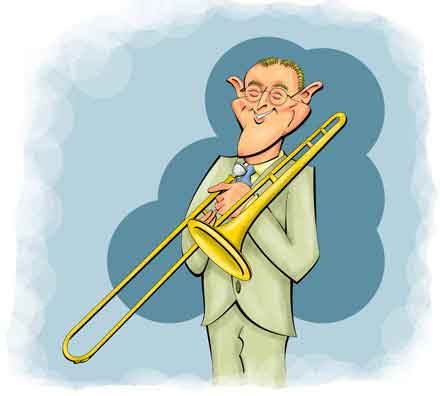
Tommy
He did, too.
But what about Red giving up music to take a shipyard job to provide a steadier income and let him stay close to home?
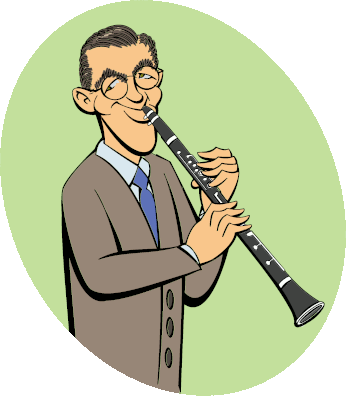
Benny
Yes, he did.
One author said flat out that Red never quit the music business. This is true but it's also false. Certainly Red took a hiatus in 1942 after he finished up a stint in Ohio. But this was a year before Dorothy's illness. Some say he quit because the war made it hard to recruit top notch musicians. Others that he wanted to contribute more directly to the war effort. Dorothy herself said her dad hadn't liked the poor bookings he had been getting and so elected to take a break.
None of these reasons are mutually exclusive. Red himself said he had tried to enlist but was turned down. So he decided to go to work for the war industry and joined the Pacific Bridge Company in Oakland, California, a job which required a security clearance. There he worked in a shipyard as a shipfitter's helper where his boss remembered him as a hard worker who everyone liked. But Red clearly saw this work as temporary and by October 1942 he had rejoined the Musicians Union. He did, though, keep working in the shipyard.
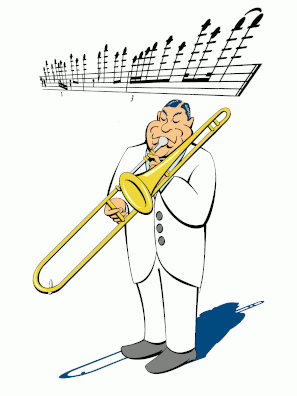
Jack Teagarden
And he.
So the movie's chronology is quite a bit off. To summarize, Red stopped performing in early 1942 and Dorothy was stricken in June 1943. Only a month later - that's a month later - a booking agency asked Red if he was interested in a job. He didn't respond to that query but rejoined the musician's union in October. Then in November, Downbeat Magazine reported that Red was planning a return. It was only three months later, in February 1944, that Red was back playing his cornet in Chicago and he continued as a professional musician until his death in 1965.
The real Red, though, did perform with Louie Armstrong. When Red reorganized his band in 1944, Louie and other musicians appeared in the show, but it was planned, not a surprise as in the movie. Another notable performance was on Bing Crosby's radio program where Louie and Jack Teagarden were joined by Red and others. This was in 1949.
There was also a wisp of truth from the movie in that Red preferred to work close to home and much of his post-War performing was around Los Angeles. But he would still take jobs in other parts of the country - on Dorothy's 16th birthday he was actually in New York - and he would take the band on tour.
There were two early tours after the war, one in 1947 and the other in 1948 (by then Dorothy was 20). Many of the spots were one nighters but others gave blessed relief where they might play for a week at a single venue. But it was an arduous schedule nevertheless. Transportation was mostly in Red's Oldsmobile station wagon, and during the two months that made up the 1948 tour they had only eight days off.
The Big Band Era had seen the rise of the vocalists who had to a large extent pushed the instrumentalists into the background. So for the tours Red hired singers Dottie O'Brien and for the second, Modie DaCosta. A young lady traveling with five guys could raise eyebrows in those more prudish days, but one of the band members, Joe Rushton, was a family friend, and Modie said he kept the "wolves" at bay.
Modie actually enjoyed the tour, grueling though it was. Since she was the only gal along she had a room to herself and she said it was like a vacation - actually getting paid to travel around and sing. She didn't make as much as the guys, and she kept expenses down by eating fruit and crackers in her room while the guys went out to eat.
After the war, the times had clearly a-changed. Electronic media had taken over popular entertainment and it wasn't going away. But for the most part good music still had to be live music, and Red found reliable and steady work on radio. Again he was able to stick close to home as many of the shows were broadcast from Hollywood. Although he would be featured with his own group, he would also sit in as a member of a program's orchestra headed by the likes of Ray Noble, John Trotter, Robert Dolan, or John Rarig. So although the programs boasted the biggest stars of the era like Edgar Bergen (and Charlie McCarthy), Roy Rogers, Al Jolson, Victor Borge, Judy Garland, Nat King Cole, Peggy Lee, Dinah Shore, Bing Crosby, and Bob Hope, Red was often not specifically mentioned.
So how much did an expert player and session man make for his efforts? Well, today it comes off as rather chintzy. One of the weekly shows where Red worked was - and this isn't a joke - The Chase and Sandborn Coffee Hour. He got $45 per performance.
Cheap? Not really. Making $45 for a show wasn't bad money at the time when Bill Monroe was paying Earl Scruggs $60 a week. By various measures of comparing value, Red was getting about $1000 in today's wages for a single program. And he also worked on other shows and so taking it all in all, he was making a pretty good living.
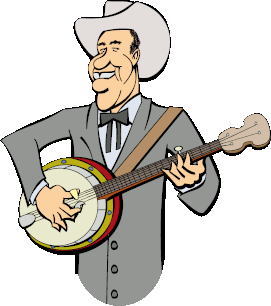
Earl Scruggs
$60 a week was good money in 1947.
As the 40's eased out and the 50's rolled in, there had come the new entertainment boon or curse depending on your point of view. That was television. Red largely avoided the boob tube, but he did appear from time to time and was usually billed with "The Five Pennies". In the few surviving clips from the 50's and 60's his music sounds pretty good.
And yes, Red did have a bass saxophone in his later groups. This wasn't Andrian Rollini who died prematurely in 1956. Instead it was Joe Rushton who handled the massive instrument with ease. For those who think the traditional Dixieland instrumentation produces too high a timbre, the bass saxophone provides a strong and quite audible lower line while allowing surprisingly intricate solos not common on other bass instruments.
A word would not be amiss about Danny Kaye who played Red in the movie. Born David Daniel Kaminsky in 1911, from the 1940's to the 1980's Danny was one of the top comics in America. Starting off in vaudeville in the 1930's he gained fame by putting his considerable musical talents to comedic effect. As we see in The Five Pennies he could deliver patter songs with complex and rapid fire lyrics (as could Louie Armstrong). Another of Danny's routines was to conduct a famous classical orchestra but to face the audience so they could see what a conductor really did. And in the 1960's he hit the pinnacle of celebrity when he hosted a popular variety show named (what else?) The Danny Kaye Show. Then in 1978 he reached to the ultimate limit of fame when he hosted The Muppet Show.
As an actor Danny began appearing in films in the 1940's and had a hit with The Secret Life of Walter Mitty which was loosely based on the 1939 short story by James Thurber. Thurber, for his part, thought Hollywood's treatment was loose indeed, and supposedly after seeing the preview he asked sourly, "Anyone catch the name of this picture?" The film, though, was one of the most popular releases of 1947. A later remake after the Millennium was even more loosely based on Thurber's story but did well monetarily if achieving less positivism with the critics.
References and Further Reading
The Red Nichols Story: After Intermission 1942-1965, Linda Evans, Scarecrow Press, 1997.
"Profiles in Jazz: Red Nichols", Scott Yanow, Profiles in Jazz, February 1, 2018.
"Ernest F. Loring 'Red' Nichols Papers, 1926-1965", University of Oregon Libraries.
"Miff Moler and His (Little Molers), The Syncopated Times.
The Five Pennies, Danny Kaye (actor), Barbara Bel Geddes (actor), Tuesday Weld (actor), Louis Armstrong (actor), Paramount, 1959, Internet Movie Data Base.
"Four Jazz Greats to Radio Concert", The Detroit Tribune, March 19, 1949, Page 15.
"Red Nichols", Discography of American Historical Recordings, University of California - Santa Barbara.
"Red Nichols", Discogs.
Bluegrass: A History, Neil Rosenberg, University of Illinois Press, 1985
Shake Well Before Using, Bennett Cerf, Simon and Schuster, 1948.
"Danny Kaye", Internet Movie Data Base.
"Purchasing Power Today of a US Dollar Transaction in the Past", Measuring Worth.